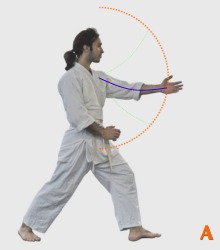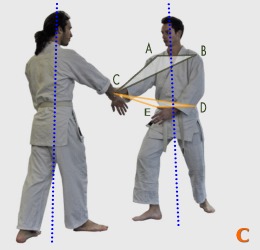


The body
The body consists of bones and muscles (these will be analyzed in this case). Bones are connected by joints. The system of bones, joints and muscles must be maintained dynamically relaxed. This means that a) the muscles shouldn't be tight, if doing so it will cause the whole body to rigid (and therefore slow) b) the muscles shouldn't be completely relaxed, if doing so the result would be the body to become quite fluid. The muscle tension should be minimized so that the system retains its elasticity (mechanics which would explain the second part).
Symmetry axis,gravity center and body mass
The body has a symmetry axis perpendicular to the body, while the gravity center is typically a few centimeters below the navel.
The body mass is distributed around the symmetry axis and the important mass is included in the upper and lower body limbs.
The body mass plays an important role in kinesiology. So, when the body must be rotated rapidly close to its symmetry axis, it is better that the mass of the body limbs to instantaneous be concentrated near the symmetry axis.To understand this principle, the trainee should bear in mind the image of a spinning top that rotates.
The mass of the body also plays an important role in the balance. If for example the trunk of the body descends rapidly down, then the one leg should go up to balance the rest of the body.To understand this principle, the trainee should bear in mind the image of a balance.
The posture
 Long term, the body should maintain a normal posture. What is this posture. This has to do with the body's posture when we are standing, when we walk in the street, etc. The body trunk is straight, upright (in relation with the ground), while the hands and feet are normally extent without being completely stretched.
Long term, the body should maintain a normal posture. What is this posture. This has to do with the body's posture when we are standing, when we walk in the street, etc. The body trunk is straight, upright (in relation with the ground), while the hands and feet are normally extent without being completely stretched.
The arms can rotate around the shoulders (e.g. like a pendulum).
 Therefore the hands under normal circumstances, e.g. without stretching the body, can contact with an object located in the periphery of a circle, a radius of maximum length,as of a hand.
Therefore the hands under normal circumstances, e.g. without stretching the body, can contact with an object located in the periphery of a circle, a radius of maximum length,as of a hand.
The clavicle of the elbow, when closed, reduces the scope.The minimum distance, from the symmetry axis of the body, that a hand can contact with an object, is when that object is located on the body, while the maximum distance of that object, is from a hand distance away of that same symmetry axis.
The same applies for the legs which revolve around the joints of the pelvis.
In case of Aikido, the hand creates a slight curve in the clavicle of the elbow, a resembling curve of a Japanese sword (katana). For that reason it's called the sword hand (te-gatana) while its action area is detected several centimeters above and below the clavicle on the wrist.
The distance from the action point
 Imagine that you greet someone by a handshake.You are located at some distance, and as you approach each other, you both raise your hands and place your handshake between the two bodies automatically, effortlessly, without power and without conscious guidance of your hands.
Imagine that you greet someone by a handshake.You are located at some distance, and as you approach each other, you both raise your hands and place your handshake between the two bodies automatically, effortlessly, without power and without conscious guidance of your hands.
The contact point is within a radius arm from the symmetry axis of each body (actually it's the shoulder but this assumption does not alter the result). The example of handshaking is similar to the attack Ai hamni katate dori.
Unlike the handshake, at martial arts the distance between two opponents is so that both are safe against a strike (atemi) e.g. from the free hand. So in the above technique, the hands meet between the two bodies, as shown in Figure B. This instantaneous equilibrium, is offered for study, therefore it will be explained in another section.
The maximum energy
Our body has maximum power when the action point (= instantaneous contact point) is located in front of the body and even so in front of the
 symmetry axis.
symmetry axis.
To achieve this let's imagine two virtual isosceles triangles. The first is created by the shoulders and hands (watch triangle ABC). The base of the triangle is the straight line between the two shoulders and the top of the triangle is the point of action. The second triangle is created in a similar way (watch triangle DEC). The base of the triangle is the straight line between the two hips and the top is still the point of action. On both triangles the peak (peak C) should be pointing the symmetry axis of the partner.
In Figure C, the technique Ai Hamni Katate Dori helps us to understand easily the two triangles shown on the attacker (uke). The same applies to the defender (nage).
This principle, of body correct positioning in relation with the action point, practically applies in all cases (techniques).
In all cases of contact the trainee should have in mind the philosophy of the contact as described in sections Aikido: The Contact, 11/2011 and Aikido: The Contact During The Technique 12/2011.